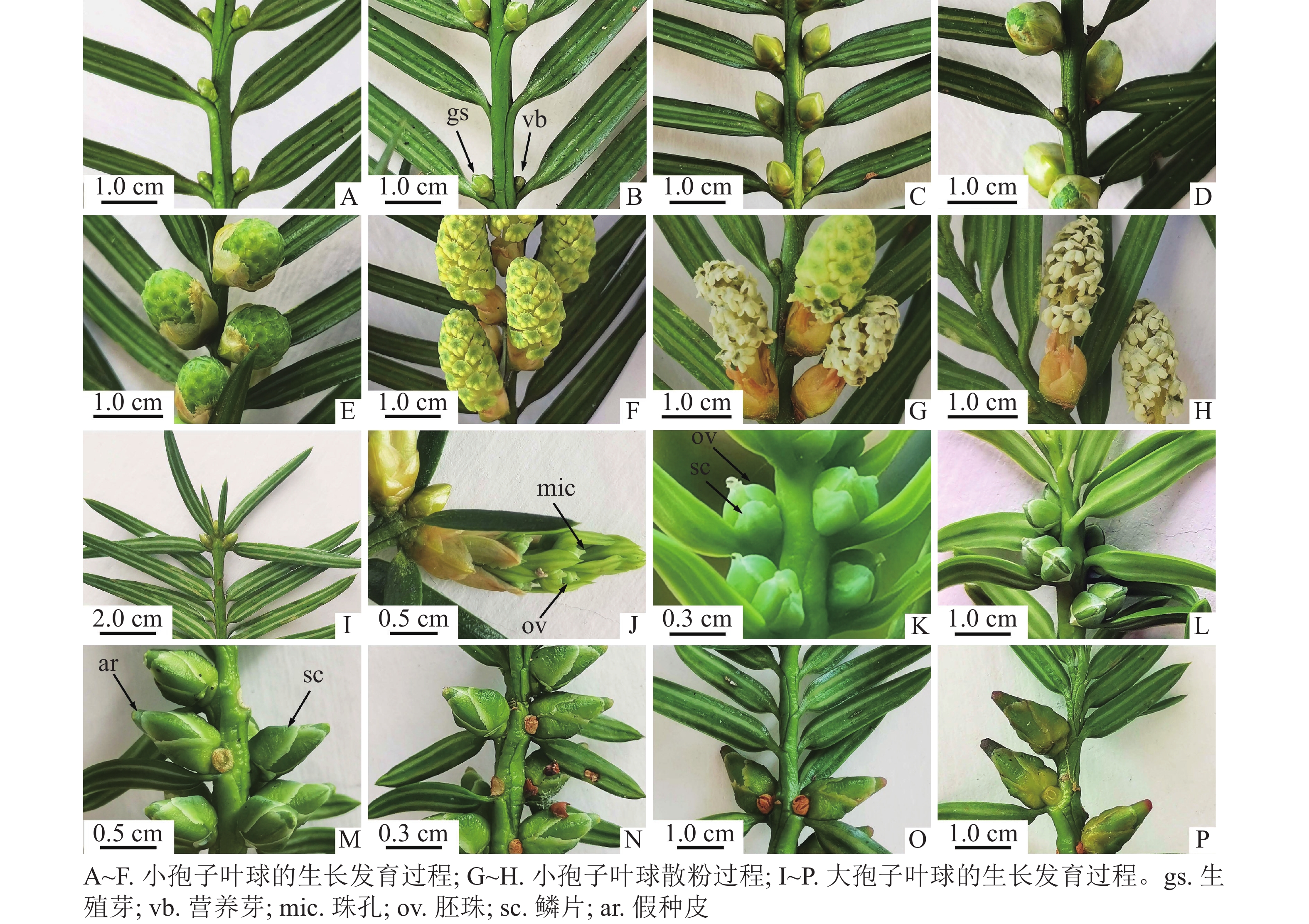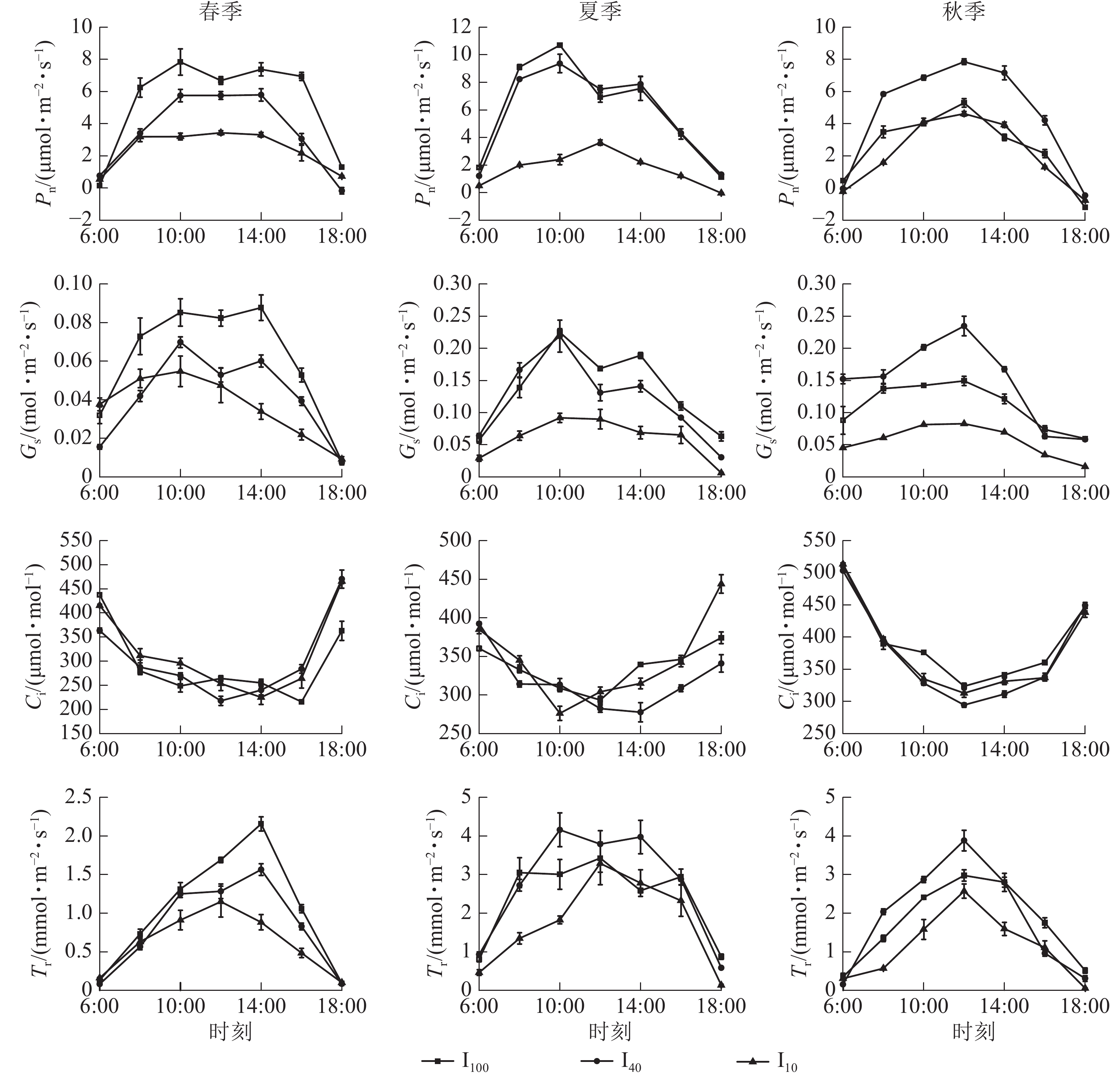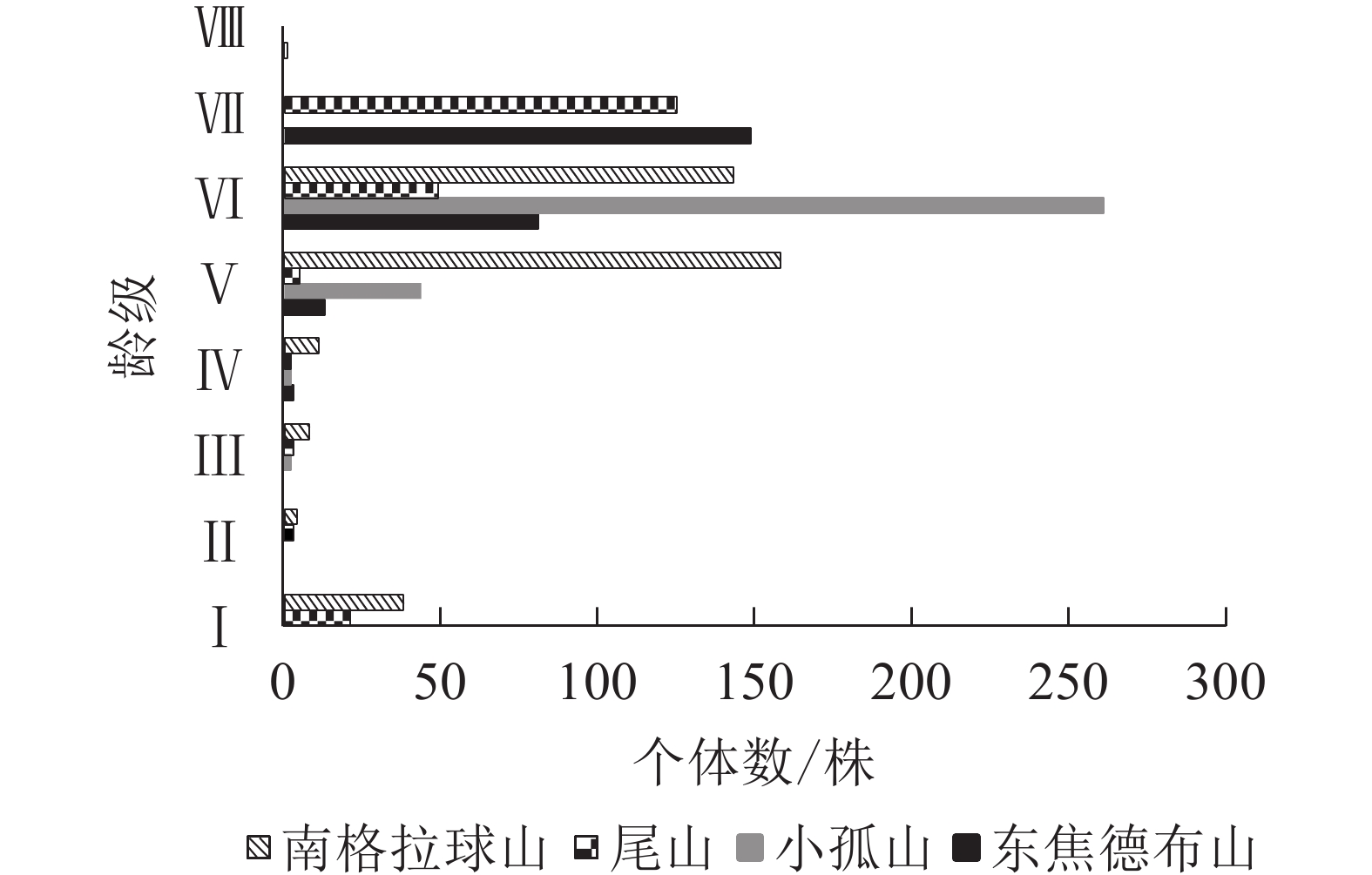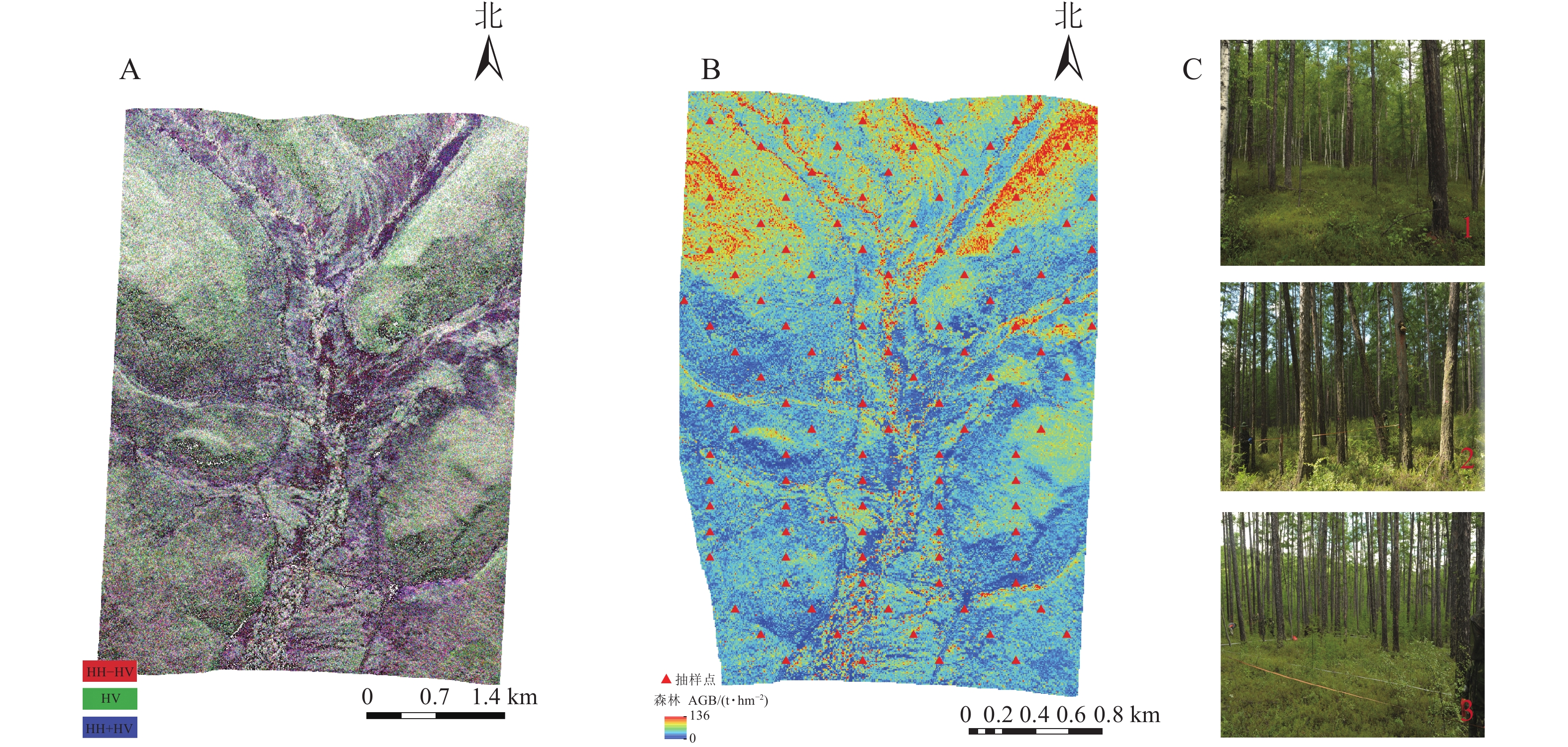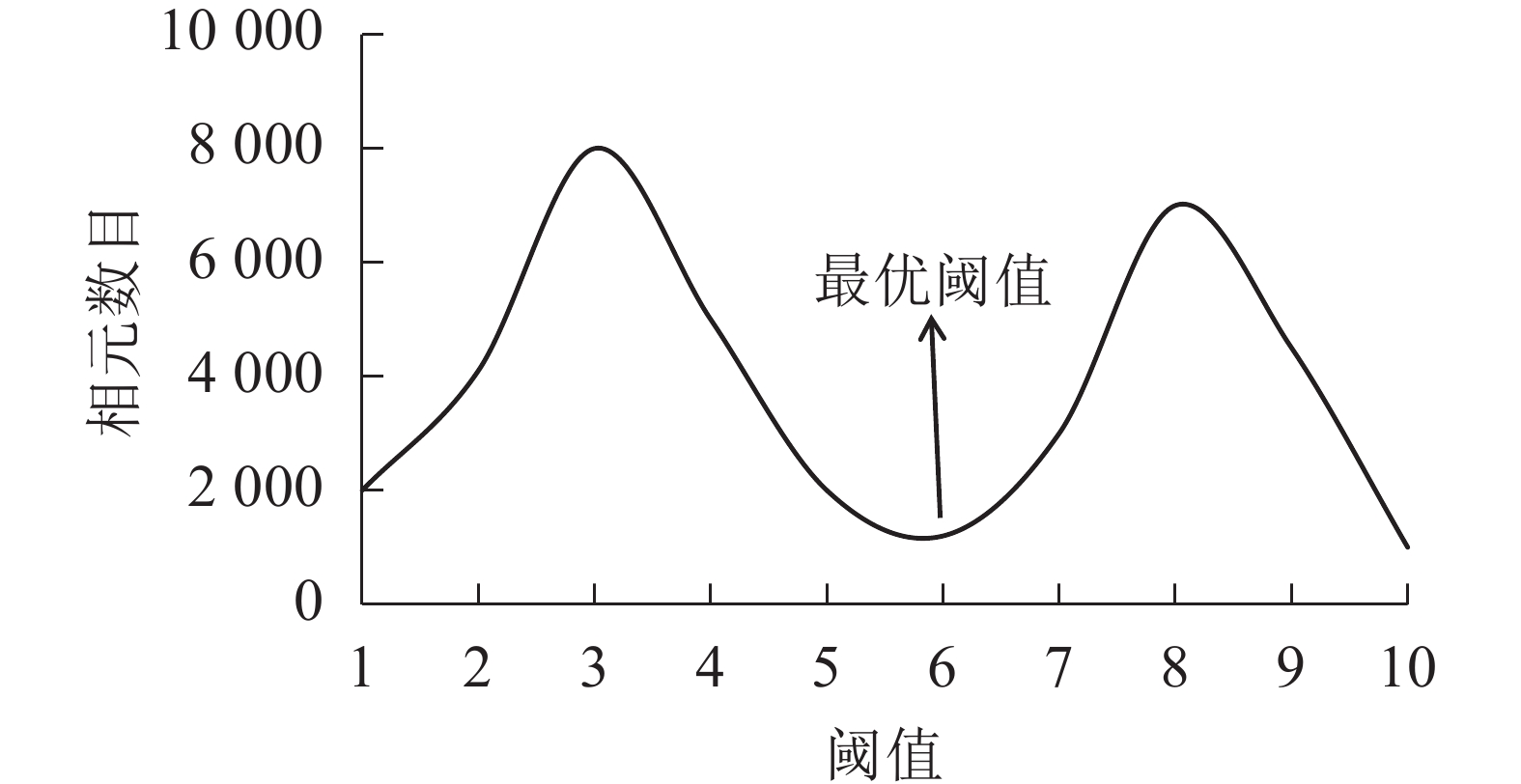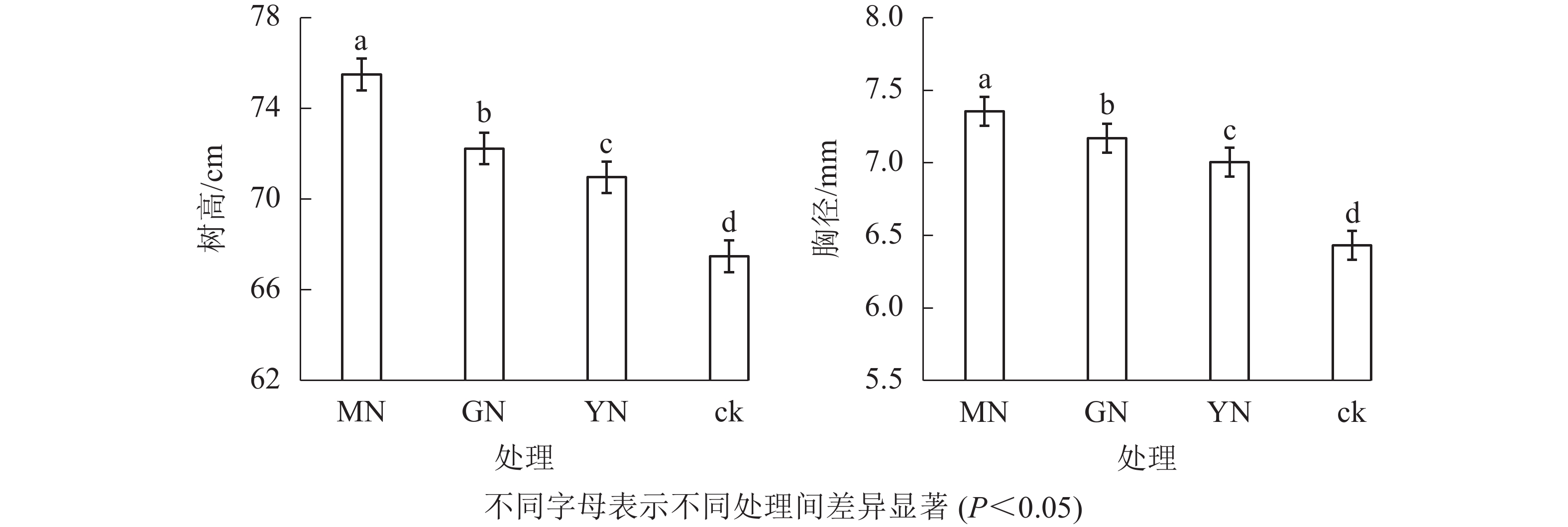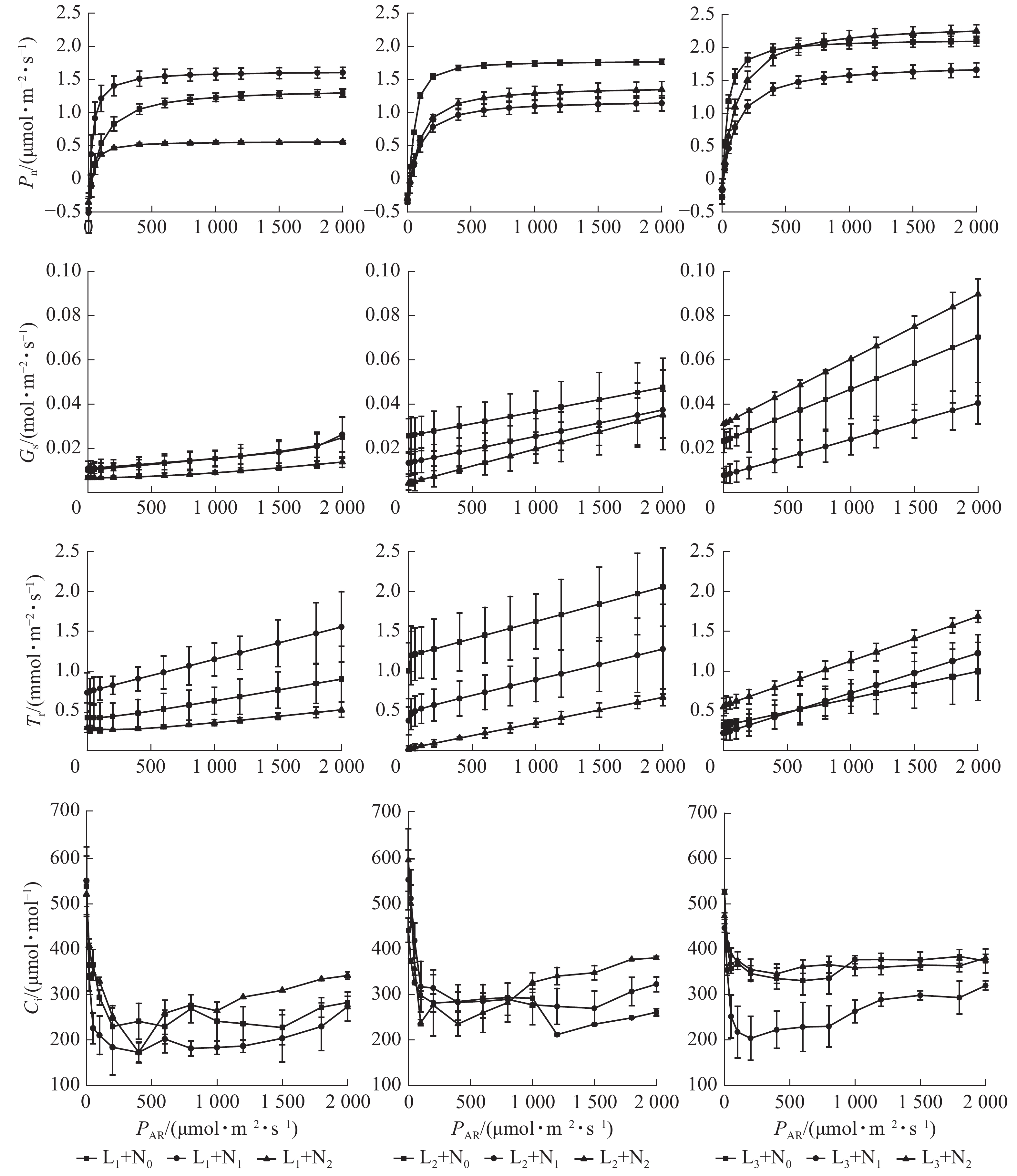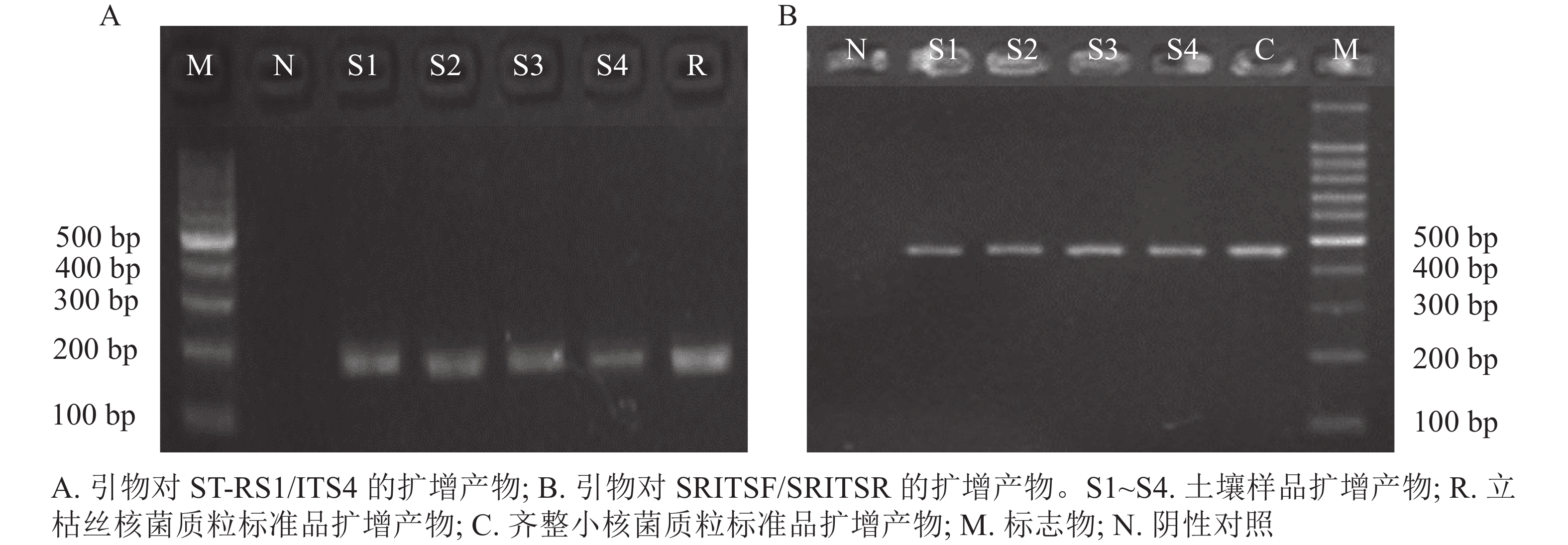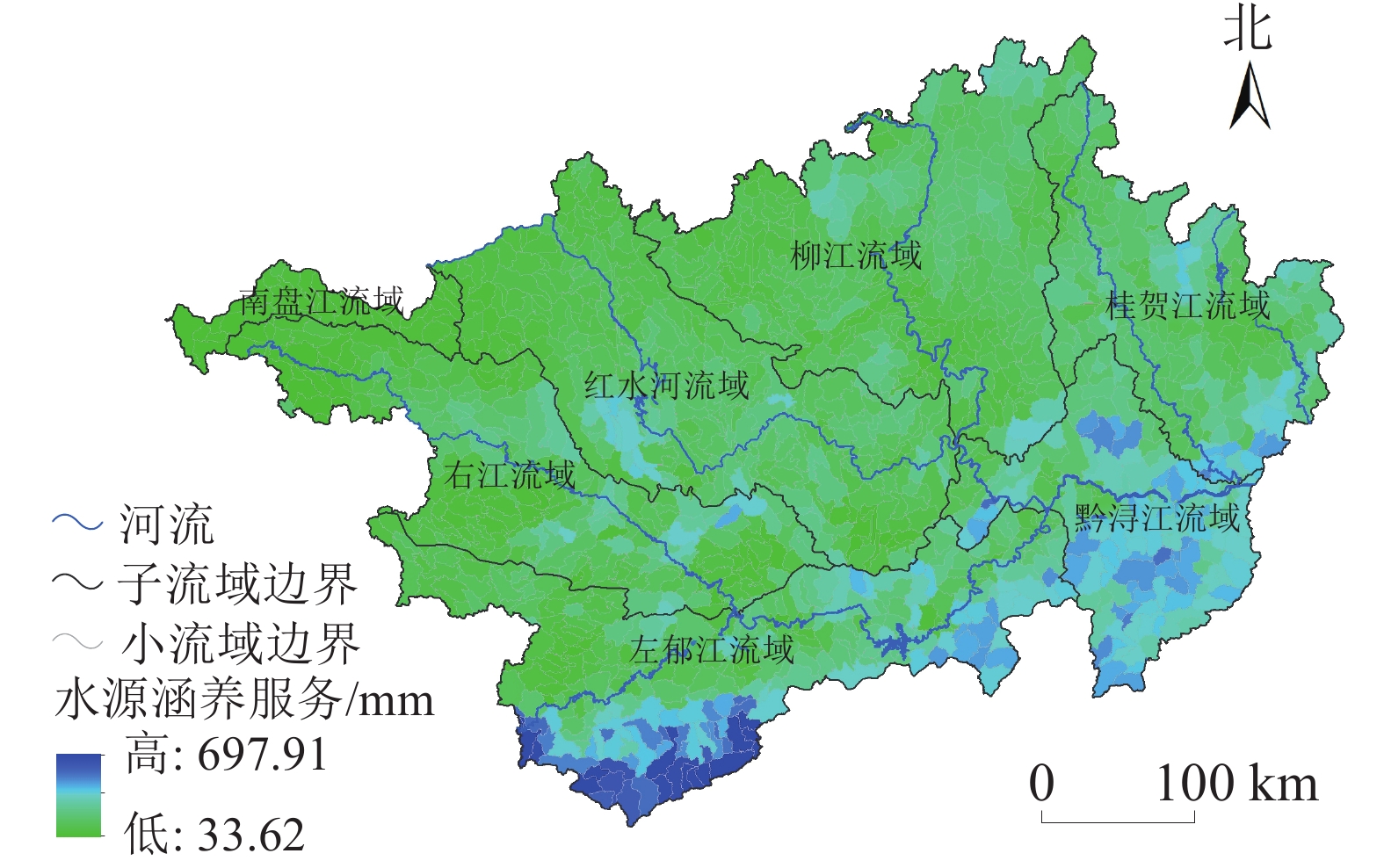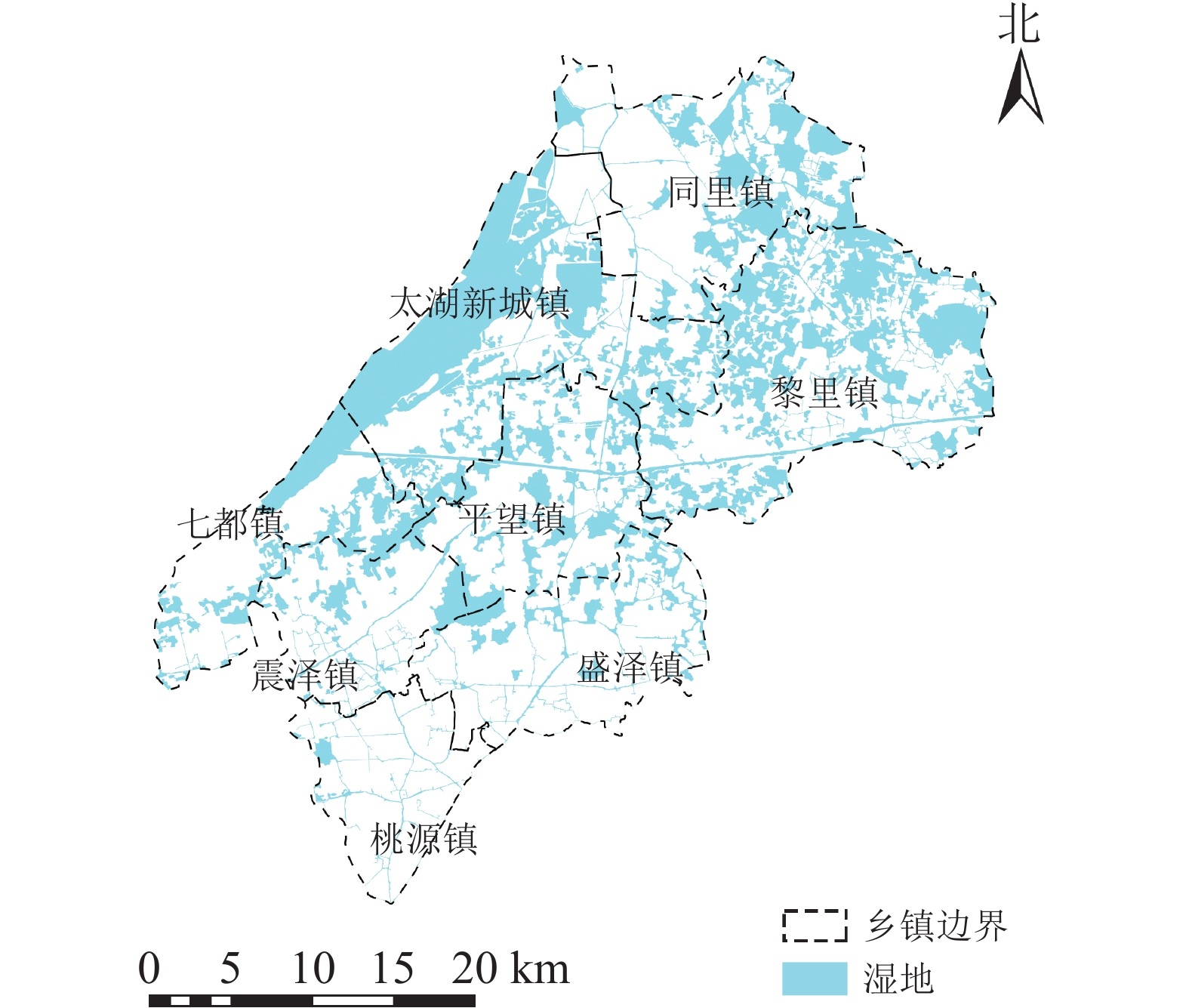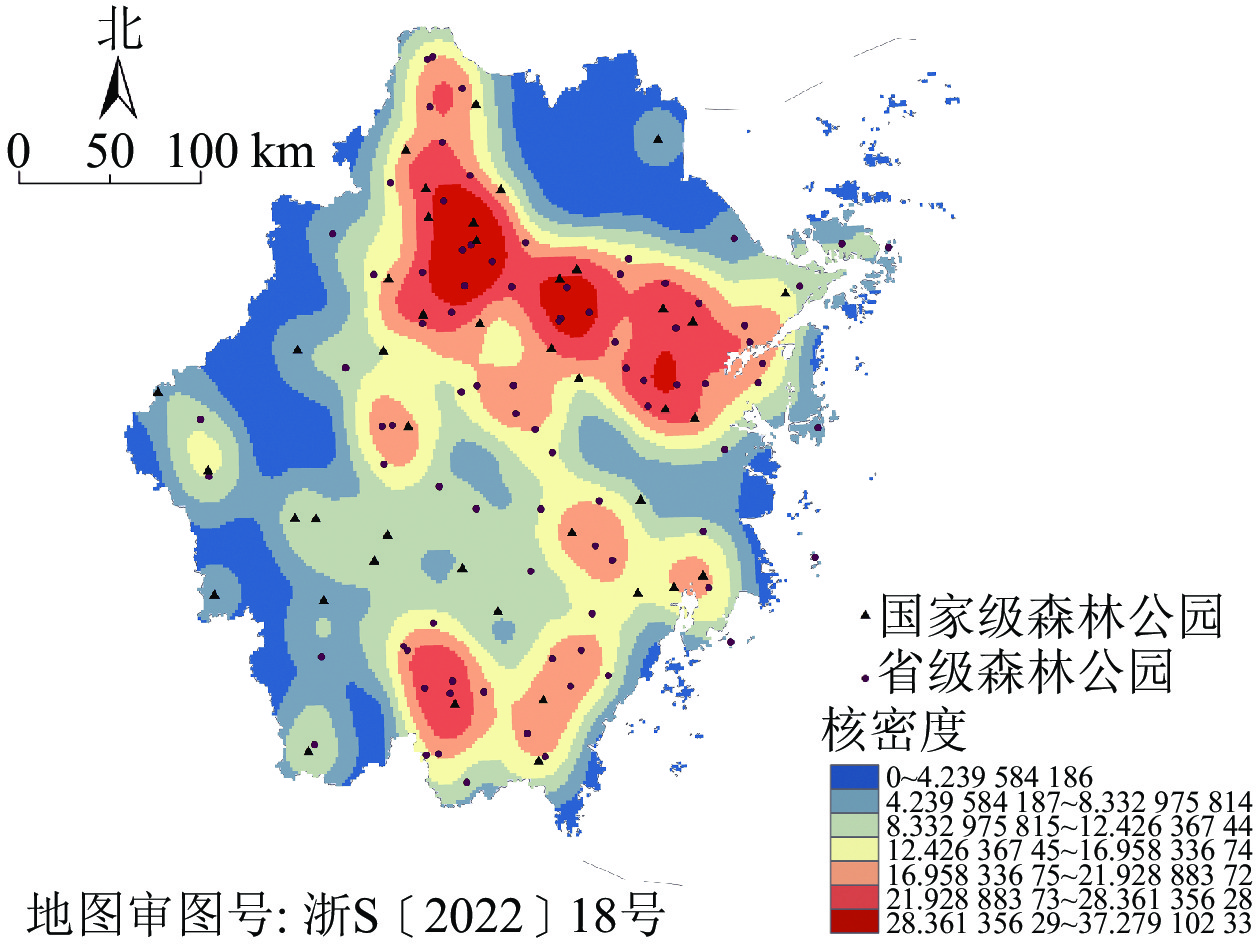2022 Vol. 39, No. 5
2022, 39(5): 923-930.
doi: 10.11833/j.issn.2095-0756.20220328
Abstract:
Objective This study, with an investigation of the diversity and endangered status of Chinese key protected wild plants (published in 2021) in Zhejiang Province and an evaluation of their respective endangerment categories, is aimed to provide reference for the design of scientific protection strategies in Zhejiang Province. Method On the basis of the second survey of protected wild plant resources in Zhejiang from 2013 to 2018, Flora of Zhejiang (New Edition) and other related investigations in recent years, an exploration was made of the species diversity along with an assessment of the endangered status of these threatened species in light of IUCN, China Biodiversity Red List—Higher Plants and others. Result (1) There are 116 Chinese key protected plants in Zhejiang and compared with the 1999 list, 3 first-class protected plants and 61 second-class protected plants were newly added, 3 species were downgraded whereas 4 species were removed. (2) They could be divided into 6 categories, among which 19 belong with the Critically Endangered (CR) species, accounting for 16.38%, 36 belong with the Endangered (EN) species, accounting for 31.03%, 30 belong with the Vulnerable (VU) species, accounting for 25.86%, 17 belong with Near Threatened species (NT) species, accounting for 14.66%, 12 belong with the Least Concern (LC) species, accounting for 10.34%, whereas 2 belong with the Data Deficiency (DD) species which accounts for 1.73%. (3) With 85 species falling into threatened species(CR, EN and VU) accounting for 73.28%, a high degree of threat was shown among the threatened plants. Conclusion Of the large number of Chinese key protected plants in Zhejiang Province, about 70 species have received great attention with plenty of research resources granted and favorable protection achieved and to better promote preservation of threatened species the following recommendations are made: (1) efforts should be devoted to the protection of the original habitat, the prevention of excessive interference, and the promotion of nature reserves and other types of nature reserves; (2) scientific researches should be conducted with improved field investigation methods, better collected habitat information of species with close attention paid to species genetic diversity; (3) multidisciplinary cooperation should be encouraged so as to establish and improve the protection network and form a complete breeding system. [Ch, 2 tab. 35 ref.]
2022, 39(5): 931-939.
doi: 10.11833/j.issn.2095-0756.20220197
Abstract:
Objective The purpose is to study the habitat adaptability and interspecific relationship of the endangered plant Sinojackia microcarpa based on population ecology, which is beneficial to its effective protection and propagation. Method Based on the community survey and habitat data of typical population of S. microcarpa in Jiande, Zhejiang Province, the species composition, niche characteristics, and the linkage between dominant species were analyzed. Result (1) A total of 401 woody plants with diameter at breast height (DBH)≥1 cm were recorded, belonging to 51 species, 50 genera, and 35 families. There were 16 species with an important value≥1% in the upper wood of the sample site, and the top 4 species with an important value ranging from large to small were Phyllostachys edulis, Cupressus funebris, Castanea mollissima, and S. microcarpa. The sum of the important values of these 4 species was 49.85%. (2) S. microcarpa had the highest niche similarity with the upper wood species such as Cinnamomum cmphora, as well as the lower wood species such as Loropetalum chinensis. The ecological overlap value was greater than 0.5. The negative interspecific association between S. microcarpa, Camellia sinensis, Loropetalum chinensis and Camellia fraterna suggested that there was significant competition between them. Conclusion Rare individuals, poor habitat conditions, and fierce interspecific competition when resources are limited are the key reasons for the extinction of S. microcarpa. [Ch, 8 tab. 33 ref.]
2022, 39(5): 940-949.
doi: 10.11833/j.issn.2095-0756.20220181
Abstract:
Objective Torreya jiulongshanensis, an ancient relict plant endemic to Zhejiang Province, is a national Class Ⅱ key protected wild plant and also listed as a protected plant of extremely small population in Zhejiang Province. The purpose of this study is to systematically observe the occurrence of megaspores and microspores of T. jiulongshanensis, as well as the development of male and female gametophytes , so as to find out whether the gametes are abnormal and the reasons for low seed-setting rate. Method The male and female individuals of T. jiulongshanensis from the type locality were collected as the research objects. Through regular observation and sampling, the occurrence of megaspores and microspores and the development of female and male gametophytes were sectioned, stained and observed by paraffin sectioning method. Result (1) The microsporophyll differentiated in mid-August, differentiated into secondary sporogenesis cells in late August and formed microspore mother cells in mid-November. In late February of the next year, it entered the meiosis stage, formed free microspore cells in mid-March, and gradually matured at the end of March. The mature pollen grains were binucleate without air sacs. The development type of microsporangium was basic type, and the spore division model was simultaneous type. The tetrad had tetrahedral and zygomorphic forms. (2) Male gametophytes began to develop in mid-to-late March, and formed sperm at the end of July. The whole process lasted about 4 months. (3) In late March of the next year, 2 erect ovules were born at the base of leaf axils of each bract in megasporophyll. In late April, the megaspore mother cell underwent meiosis Ⅰ and Ⅱ, and formed 4 linear megaspores. In mid-May, 3 megaspores at the micropylar end degenerated and the megaspores at the chalazal end finally developed into female gametophytes. (4) T. jiulongshanensis had 2 solitary oval archegonia, which lasted about 7 months from pollination to fertilization. Conclusion The development cycle of male and female reproductive system of T. jiulongshanensis is longer than that of other species in the family Taxaceae. The main reasons for low seed-setting rate and difficult natural regeneration of T. jiulongshanensis include long reproductive cycle, complicated reproductive process, the development of female reproductive system which lags behind that of the male reproductive system, as well as the extremely limited population (1 female plant and 2 male ones). [Ch, 3 fig. 1 tab. 34 ref.]
2022, 39(5): 950-959.
doi: 10.11833/j.issn.2095-0756.20210814
Abstract:
Objective This study, with an investigation of the seasonal variation of photosynthetic capacity and adaptation mechanism of Magnolia sinostellata, an endangered plant under different light intensity, is aimed to provide a theoretical basis for population reproduction and rejuvenation and ex-situ protection. Method With two-year-old seedlings planted under three light conditions, including 100% of natural light intensity, 40% of natural light intensity, and 10% of natural light intensity, their photosynthetic characteristics in spring, summer and autumn were measured respectively. Result (1) The diurnal variations of the net photosynthetic rate of M. sinostellata under 100% of natural light intensity in spring and 100% of natural light intensity and 40% of natural light intensity in summer were all featured with a bimodal curve. (2) The maximum net photosynthetic rate, light saturation point, light compensation point under 100% of natural light intensity and 40% of natural light intensity in summer were significantly higher than those under 10% of natural light intensity whereas the maximum net photosynthetic rate and light saturation point under 100% of natural light intensity in autumn were significantly lower than those under 40% of natural light intensity and 10% of natural light intensity (P<0.05). (3) The maximum rate of electron transport and triose phosphate utilization rate under 100% of natural light intensity in summer and autumn were significantly lower than those under 40% of natural light intensity(P<0.05). (4) Under 100% of natural light intensity, the maximum quantum yield of photochemical energy conversion (Fv/Fm) value was 0.68 in summer and 0.72 in autumn while the photochemical quenching and the effective quantum yield of photochemical energy conversion under 40% of natural light intensity in summer were significantly higher than that in spring and autumn (P<0.05). Conclusion Under 100% of natural light intensity, the net photosynthetic rate of M. sinostellata seedlings in autumn significantly decreased, which might attribute to the damage done to leaves by the high temperature and high intensity of light in summer. However, M. sinostellata seedlings under proper shading could maintain relatively higher photosynthetic rate in three seasons. Therefore, it is recommended that photosynthetically active radiation at more than 40% of the natural light intensity is adopted in cultivation. [Ch, 5 fig. 1 tab. 23 ref.]
2022, 39(5): 960-970.
doi: 10.11833/j.issn.2095-0756.20210785
Abstract:
Objective This study aims to investigate the population structure characteristics of Quercus mongolica on the south slope of four old volcanoes in Wudalianchi, reveal the survival status of the population and predict the population development trend, so as to provide scientific basis for the succession, restoration and sustainable development of forest vegetation in Wudalianchi. Method Based on field survey and data analysis, the population age structure diagram, static life table, and survival curve were drawn. The population structure and dynamics were studied using survival analysis and quantitative dynamics analysis. The population development trend was predicted by time-sequence model. Result The population of Q. mongolica in the four volcanoes was young and insufficient, mainly composed of mature trees of age class Ⅴ−Ⅶ, which showed a stable population, and the survival curve was Deevey Ⅱ type. The survival analysis showed that the four populations gradually declined in the early stage and tended to be stable in the middle stage, but the risk function increased sharply, and the population began to enter the physiological decline period after this age class, indicating that the population had a decline trend in the later stage. The population dynamic analysis indicated that the population index Vpi of Q. mongolica in East Jiaodebu Volcano, Xiaogu Volcano and South Gelaqiu Volcano was greater than 0, belonging to the growing type, and V'pi was equal to or close to 0, indicating that the population was a stable type. The population dynamic index Vpi <0 and V'pi<0 in Wei Volcano indicated that the population was a declining type. And the four populations were highly sensitive to external random interference. Time series prediction showed that the number of Q. mongolica individuals of the four populations would decrease after 2, 4, and 6 age classes in the future. Conclusion The four populations are stable at present, but the number of individuals decreases significantly due to the limited resources in the sapling stage, which leads to the low development potential of aged individuals in the population and forms a bottleneck of regeneration and development, and the population tends to decline in the later stage. [Ch, 5 fig. 5 tab. 40 ref.]
2022, 39(5): 971-980.
doi: 10.11833/j.issn.2095-0756.20220111
Abstract:
Objective Forests play an important role in carbon sequestration in terrestrial ecosystems. The spatial accurate quantification of forest biomass is of great significance to understand terrestrial carbon reserves, carbon budget, carbon balance and the resulting global climate change. Taking the advantage of the longer wavelength of P-band and higher penetration ability in the forest, the feasibility of improving the accuracy of forest above ground biomass (AGB) estimation using airborne P-band SAR data need to be studied . Method Based on the domestic airborne P band full polarimetric SAR data, 20 polarimetric SAR features are extracted, and were analyzed their sensitivity to change of forest AGB. Multiple linear regression model (MLR), k-nearest neighbor method (KNN), support vector regression (SVR) and random forest (RF), which were more popular forest AGB estimation models in previous studies, were used and compared in forest AGB estimation in this study. Result The results showed that polarimetric features including co-polarimetric backscatter coefficients, odd and double bounce scattering components extracted from Freeman-Durden and Yamaguchi decomposition methods, alpha from H-A-ALPHA decomposition method and polarization discrimination ratio (PDR), the extended polarimetric feature were sensitive to the change of forest AGB. The relative errors of estimated AGB using the four estimation methods were all about 30%, among which the accuracy of MLR estimation result was the lowest, with accurancy of 63.55% and root mean square error (RMSE) of 19.16 t·hm−2; The accuracy of RF estimation result was the highest, with Acc of 72.97% and RMSE of 15.98 t·hm−2; There is no significant difference between the accuracies between the estimated results of KNN and SVR, and the values of RMSE for them were 17.04 and 17.09 t·hm−2, respectively. Conclusion P-band SAR data has certain potential for estimating forest AGB. The estimation results of nonparametric method are significantly better than those of MLR. The AGB estimation accuracy of P-band is obviously affected by the level of forest AGB to be estimated, and the estimation accuracy is higher in the group with higher forest AGB level. In the study area, with an average forest AGB around 45 t·hm−2 and maximum value around 120 t·hm−2, the accurancy value for the estimated forest AGB at group with all AGB values lower than 50 t·hm−2 was lower around 6% than the value at group with all forest AGB values higher than 50 t·hm−2. [Ch, 5 fig. 3 tab. 34 ref.]
2022, 39(5): 981-988.
doi: 10.11833/j.issn.2095-0756.20210576
Abstract:
Objective Due to the growth and management characteristics of Phyllostachys edulis forest, the canopy density of Ph. edulis forest is a very important factor in the management. This study aims to explore the estimation method of canopy density of Ph. edulis forest based on unmanned aerial vehicle (UAV) visible image, which can achieve real-time and rapid acquisition of Ph. edulis forest canopy density. Method The visible light image of Ph. edulis forest of common rotor UAV was taken as the research object. 4 mature digital image processing methods were adopted, namely, threshold classification based on pixel, supervised classification based on pixel, threshold classification based on multi-scale segmentation, and supervised classification based on multi-scale segmentation. 36 sample plots with different truncation conditions and canopy density were selected. Using the existing software and MATLAB programming, the Ph. edulis canopy area in each sample plot was rapidly extracted, and then the canopy density was estimated. The estimation accuracy of the canopy density of each method was compared with the true value calculated by visual interpretation, and the performance of the 4 methods under different truncation and different canopy density conditions was compared and analyzed. Result The overall accuracy of threshold classification based on pixel, supervised classification based on pixel, threshold classification based on multi-scale segmentation, and supervised classification based on multi-scale segmentation was 91.81%, 92.96%, 93.47% and 98.86%, respectively. The absolute error of the estimated value of canopy density of the 4 methods was 0.038, 0.030, 0.024 and 0.004, respectively. Truncation condition and canopy density had no significant effect on the extraction results. Conclusion The supervised classification method based on multi-scale segmentation has the highest overall accuracy and the smallest absolute error. It can quickly and accurately extract and estimate the canopy density of Ph. edulis forest, and is suitable for different management types of Ph. edulis forest. [Ch, 2 fig. 6 tab. 28 ref.]
2022, 39(5): 989-997.
doi: 10.11833/j.issn.2095-0756.20210641
Abstract:
Objective As a unique Camellia tree species in south China as well as an emerging resource of Camellia with oil, medicinal and ornamental value, Camellia chekiangoleosa has great development potential. Therefore, this study is aimed to make a prediction of the potential distribution range of C. chekiangoleosa and conduct an analysis of the main environmental variables which impact its distribution so as to promote its conservation, utilization and introduction. Method With the employment of MaxEnt model, on the basis of the environmental variables of 55 distribution points in China, a prediction was made of the potential geographical distribution and change of C. chekiangoleosa in China under three RCPs climate change scenarios. Result (1) Precipitation of the coldest quarter, temperature and soil characteristics were the main environmental factor affecting the potential distribution with the first contributing the most, followed by the second and the third; (2) With central and southern China as the potential distribution areas currently, the core areas are mainly located in Jiangxi, Fujian and Zhejiang; (3) With future climate change as a norm, the overall potential distribution areas will expand to different degrees, showing a significant expansion trend from central China to the southwest. Conclusion Precipitation, temperature and soil characteristics were the main factors affecting the potential distribution of C. chekiangoleosa, with altitude playing a less significant role. It was also found that C. chekiangoleosa enjoys wide range of potential distribution in most areas of south China where efforts in their introduction, cultivation and popularization should be encouraged. [Ch, 2 fig. 2 tab. 41 ref.]
2022, 39(5): 998-1009.
doi: 10.11833/j.issn.2095-0756.20210742
Abstract:
Objective Jasmonal amino acid conjugate synthase (JAR1) can catalyze jasmonic acid (JA) to form jasmonic acid-soleucine (JA-Ile), an active form of jasmonic acid, and activate the JA signal pathway. JA signaling pathway plays an important role in mediating the response of plants to salt stress. This study aims to explore the function of AtJAR1 in plant salt tolerance, which plays an important role in studying the mechanism of JA signal pathway affecting plant salt tolerance. Method CRISPR/cas9 gene editing technology was used to create two different Arabidopsis thaliana AtJAR1 gene mutants. The aboveground biomass of the two mutants and the expression of JA signal marker gene were analyzed to determine the loss of AtJAR1 gene function. Then, the effects of different concentrations of NaCl and ABA treatment on seed germination and seedling establishment of jar1 mutants were observed and analyzed to clarify the effect of AtJAR1 gene on salt tolerance of A. thaliana. Finally, the role of AtJAR1 gene in salt tolerance of A. thaliana was investigated by comparing the content of potassium and sodium ions in wild type and mutants before and after salt treatment, as well as the expression of AtHAK5, a high affinity potassium ion transporter gene. Result The expression of JA signal marker genes AtVSP1 and AtVSP2 decreased significantly, indicating the loss of AtJAR1 gene function. Different from the jar1-1 mutant produced by point mutation, the growth of the two mutants accelerated in the first three weeks, then gradually slowed down and the leaves wilted. At the same time, AtJAR1 mutation can alleviate the inhibition of salt stress and ABA on seed germination and root growth. In addition, AtJAR1 mutation can promote the expression of AtHAK5 and the absorption and transport of potassium ions in roots under salt stress. Conclusion JA signaling pathway may affect the expression of AtHAK5 through interaction with ABA, so as to regulate the absorption and transport of K+ by plant roots, change the intracellular K+/Na+ balance, and finally affect plant salt tolerance. [Ch, 8 fig. 2 tab. 52 ref.]
2022, 39(5): 1010-1017.
doi: 10.11833/j.issn.2095-0756.20210782
Abstract:
Objective To explore the effects of low phosphorus (P) stress on rhizosphere soil nutrient environment, as well as the growth and nutrient physiology of Phyllostachys edulis seedlings at different growth stages and their sustained effects, so as to analyze the adaptation mechanism of Ph. edulis seedlings to low P stress. Method Seeds of Ph. edulis were sown in pots to cultivate young seedlings. Rhizosphere soil nutrient environment, the biomass and its distribution of Ph. edulis seedlings, and the nutrient absorption, utilization and distribution of Ph. edulis seedlings at the end of the current growing season (T1) and the next rapid growing season (T2) were determined under four different soil available phosphorus conditions, 2.5 mg·kg−1 (very low phosphorus, P1), 5.0 mg·kg−1 (low phosphorus, P2), 10.0 mg·kg−1 (medium phosphorus, P3), 20.0 mg·kg−1 (suitable phosphorus, P4). Result Low P treatment group (P1, P2) significantly decreased pH in rhizosphere soil (P<0.05), and maintained the high N content of the rhizosphere soil at T1; The low P effect continued to T2, and the organic matter content of rhizosphere soil of P1 and P2 was significantly increased by 10.70% compared with that of P4 at this season (P<0.05). Low P treatment group significantly reduced the biomass and the accumulation of N, P, K nutrients of Ph. edulis seedlings at both stages (P<0.05), but the decline at T2 was higher than that at T1. At T1, the low P treatment group significantly reduced the root shoot ratio (R/S) and relatively reduced the proportion ratio of nutrients in the root of Ph. edulis seedlings; However, at T2, the R/S of the low P treatment group was significantly increased by 44.30% and 37.97% compared P4 (P<0.05), and the distribution ratio of N and K nutrients in the root was also significantly increased. The low P treatment group significantly increased the phosphorus use efficiency (PUE) of the whole plant of Ph. edulis seedlings (P<0.05), the PUE decreased with the passage of seedlings time, only P1 significanlty increased by 19.05% compared with P4 at T2 (P<0.05). Conclusion Low P stress inhibited the growth and nutrient accumulation of Ph. edulis seedlings, but increased the overall PUE. With the extension of seedling time to the next rapid growing season, the inhibition effect of low P stress on the plant was enhanced, but the adaptability of Ph. edulis seedlings to low P stress was improved by increasing the root-shoot ratio and the proportion of nutrient distribution to root. [Ch, 2 fig. 4 tab. 25 ref.]
2022, 39(5): 1018-1027.
doi: 10.11833/j.issn.2095-0756.20210704
Abstract:
Objective This study aims to explore the effect of physical barrier of litter from Metasequoia glyptostroboides mother tree on its natural regeneration, so as to provide scientific basis for removing obstacles of M. glyptostroboides natural regeneration and protecting its population. Method Through field simulation experiments, different types of litter (fresh litter and natural litter) with different mass gradients (0, 100, 300, 500, 700 and 900 g·m−2) were used to investigate the effect of litter on emergence and early growth of M. glyptostroboides seedlings by spreading litter on the lower layer of seeds and covering litter on the upper layer of seeds. Result (1) Litter inhibited the seed emergence rate and seedling survival rate of M. glyptostroboides, and the inhibitory effect was significantly enhanced when the litter mass was 300−900 g·m−2 (P<0.05). (2) Except for spreading natural litter on the lower layer of seeds, the other treatments promoted the growth of seedling height and ground diameter M. glyptostroboides seedlings when the litter mass was 300 g·m−2 (P>0.05), but the difference with the control was not significant. When the litter mass was higher than 300 g·m−2, all treatments inhibited seedling growth. With the increase of litter mass, the inhibitory effect on the root length of M. glyptostroboides seedlings enhanced gradually. (3) With the increase of litter mass, the aboveground biomass and underground biomass of M. glyptostroboides seedlings first increased and then decreased. There was a certain fluctuation only after 300 g·m−2 natural litter treatment on the low layer of seeds, and the other treatments inhibited the underground biomass accumulation of seedlings. The accumulation of aboveground and underground biomass of seedlings was significantly hindered when the litter mass was above 500 g·m−2 (P<0.05). (4) Under the same litter mass (>300 g·m−2), the inhibitory effect of fresh litter on the emergence and early growth of M. glyptostroboides seedling was greater than that of natural litter, and the inhibitory effect of litter on the lower layer of seeds was stronger than that on the upper layer of seeds. Conclusion The litter of M. glyptostroboides mother tree has an obvious physical barrier effect on the emergence and early growth of M. glyptostroboides seedlings, which affects the natural regeneration of M. glyptostroboides. Therefore, it is suggested to treat the litter of different types under M. glyptostroboides forests in time before the peak of seed rain, so as to promote the natural regeneration of M. glyptostroboides. [Ch, 4 fig. 2 tab. 29 ref.]
2022, 39(5): 1028-1036.
doi: 10.11833/j.issn.2095-0756.20210740
Abstract:
Objective This study aims to explore the effects of arbuscular mycorrhizal (AM) fungal symbiosis on growth and photosynthetic characteristics of Fraxinus malacophylla in rocky desertification habitats, so as to provide data reference for selecting dominant AM fungal species for vegetation restoration. Method An experiment was designed with four treatments: Funneliformis mosseae+agroforestry biofertilizer (MN), Claroideoglomus etunicatum+agroforestry biofertilizer (YN), Rhizophagus intraradices+agroforestry biofertilizer (GN) and agroforestry biofertilizer (ck). The changes in F. malacophylla growth (tree height, diameter at breast height, leaf and root biomass, leaf area, leaf pigment and chlorophyll) and photosynthetic characteristics (net photosynthetic rate, stomatal conductance, intercellular CO2 concentration, transpiration rate, and leaf water use efficiency, etc.) were measured under different treatments. Result (1) Inoculation with AM fungi significantly promoted the growth of F. malacophylla and biomass accumulation of leaf and root(P<0.05). (2) Inoculation with MN and GN significantly increased the relative contents of chlorophyll a, chlorophyll b and lutein in plant leaves (P<0.05), and the increase rate was 6%−67%. (3) Inoculation with AM fungi significantly increased the net photosynthetic rate, stomatal conductance, transpiration rate, and water use efficiency of F. malacophylla (P<0.05), but significantly decreased the intercellular CO2 concentration (P<0.05). (4) Principal component analysis indicated that the stomatal conductance, tree height, and lutein were the key factors to increase the net photosynthetic rate, with an average contribution rate of 45.81%, followed by chlorophyll b, biomass and total chlorophyll. Conclusion AM fungal symbiosis can significantly improve the net photosynthetic rate of F. malacophylla by promoting plant growth and photosynthetic pigment content. The optimal strain is F. mosseae. [Ch, 5 fig. 2 tab. 33 ref.]
2022, 39(5): 1037-1044.
doi: 10.11833/j.issn.2095-0756.20210605
Abstract:
Objective This study aims to screen the combination treatment of light intensity and nitrogen application that is more conducive to the expression of photosynthetic physiological parameters, so as to reveal the relationship between the changes of light intensity and nitrogen and the growth of Styrax obassia seedlings. Method Potted seedling cultivation method was adopted to construct the two-factor control test of light and nitrogen. Four shading treatments were prepared: all-light control with 100.00% transmittance, light shading with 47.30% transmittance (L1), moderate shading with 20.00% (L2) and high shading 7.75% (L3). Three nitrogen application treatments were included: N2 (0.63 g pure nitrogen), N1 (0.21 g pure nitrogen) and N0 (no nitrogen application). The light response process and the variation characteristics of photosynthetic pigment content were determined and analyzed. Result (1)With the increase of shading degree and nitrogen application rate, net photosynthetic rate (Pn), apparent quantum efficiency (AQY) and total chlorophyll (Chl) content of S. obassia seedlings increased, while dark respiration rate (Rd) decreased, and light saturation point (LSP) ranged from 140.00 to 481.33 μmol·m−2·s−1. Light compensation point (LCP) varied from 6.00 to 34.67 μmol·m−2·s−1, and the ratio of Chl a to Chl b was less than 2. (2) Under all light and L1 shading+N2 treatment, the plants died. (3) Under L1 shading, the change of Pn ranging from large to small was N1, N0, and N2. Under L3 shading, when photosynthetic effective radiation (PAR)was greater than 400 μmol·m−2·s−1, the Pn of N2 was significantly higher than that of N0 and N1 (P<0.05). (4) Both light intensity and nitrogen application had significant effects on photosynthetic pigment content (P<0.01), and the influence trend in descending order was light, nitrogen, and light+nitrogen. Conclusion The seedlings of S. obassia have strong shade tolerance, and the optimal combination treatment of light and nitrogen is L3+N2. [Ch, 1 fig. 3 tab. 26 ref.]
2022, 39(5): 1045-1051.
doi: 10.11833/j.issn.2095-0756.20210829
Abstract:
Objective This study aims to explore the feasibility of using green waste compost as the Cosmos bipinnata cultivation substrate instead of peat, so as to achieve the scientific, economic and effective utilization of green waste and reduce the use of peat in flower cultivation. Method Green waste compost and peat were prepared into 5 kinds of cultivation substrates according to different proportions [100% green waste compost (T100), 75% green waste compost+25% peat (T75), 50% green waste compost+50% peat (T50), 25% green waste compost+75% peat (T25), and 100% peat (T0)]. T100 and T0 were used as the control for the cultivation test of C. bipinnata. By comparing the physical and chemical properties of different cultivation substrates and the growth index of C. bipinnata, the cultivation substrate with the best proportion of garden waste compost and peat was selected. Result Adding green waste compost could significantly increase the contents of total nitrogen, total phosphorus, total potassium, available phosphorus, and available potassium in the cultivation substrate(P<0.05), and improve the bulk density, maximum water content, total porosity, aeration pores, and acid-base environment of the cultivation substrate. The physical and chemical properties of the cultivation substrate were the best when the addition ratio of green waste compost was 50%. Compared with the control (T0), the fresh weight of aboveground parts, the dry weight of aboveground parts, the fresh weight of underground parts, and the dry weight of underground parts in T50 culture increased by 390.4%, 322.2%, 145.6%, and 93.1%, respectively. The plant height, the flower number, and the root length of C. bipinnata increased by 137.4%, 109.0%, and 95.7% respectively. Conclusion Green waste compost can partially replace peat for C. bipinnata cultivation, and the cultivation substrate composed of 50% green waste compost + 50% peat is the most favorable for the growth of C. bipinnata, which can better replace peat as the cultivation substrate of C. bipinnata for garden greening. [Ch, 5 tab. 25 ref.]
2022, 39(5): 1052-1058.
doi: 10.11833/j.issn.2095-0756.20210587
Abstract:
Objective This study is aimed to screen out Syringa plants with strong dust-retention capability so as to promote the ecological function of Syringa in urban greening. Method With six species of Syringa selected as the research materials, the three-layer filter method was first used to determine the particles of plants passing through filters with different pore sizes during the full-leaf period. Then the micromorphology of the leaf surface of the Syringa was observed before an investigation was conducted of the influence of the leaf micromorphology and the dust retention effect of the plant. Result (1) there were significant differences in the dust retention capabilities of Syringa plants(P<0.05) with the order of the comprehensive dust-retention capability per unit leaf area of the 6 Syringa species for the full-leaf stage being S. chinensis>S. pekinensis>S. vulgaris>S. oblata>S. reticulata var. amurensis>S. oblata var. alta. (2) it can be seen that S. chinensis had the strongest comprehensive dust-retention capability per unit leaf area whereas through microstructure observation, it was found that the upper surface of the assorted S. chinensis had deep grooves and dense folds around the stomata on the lower surface, which helps with the retention of particles. (3) from the perspective of the partial correlation coefficient, there isn’t a significant correlation (P>0.05) between the leaf surface micromorphology parameters and the retention of dust (UTSP and UPM2.5). Conclusion The depth of the trench may be one of the factors that affect the dust retention of plants and S. chinensis is recommended as an excellent garden dust-retaining shrub specie and can be widely used to retent dust pollution. [Ch, 2 fig. 3 tab. 26 ref.]
2022, 39(5): 1059-1066.
doi: 10.11833/j.issn.2095-0756.20210402
Abstract:
Objective The purpose is to explore the difference of Cd absorption and accumulation among different low absorption rice (Oryza sativa) cultivars in Cd polluted farmland and their distribution characteristics in different growth stages. Method 5 cultivars with low Cd absorption were selected: ‘Zhongzheyou 1’, ‘Zhongzheyou 8’,‘Huazheyou 71’,‘Yongyou 17’and‘Yongyou 1540’. A field experiment was carried out in a village of Jingning County, Lishui City, Zhejiang Province, to explore the growth and Cd uptake and transport characteristics of 5 low absorption cultivars of rice. Result There were differences in the accumulation of Cd in different organs of the same rice variety. At jointing stage and booting stage, the mass fraction of Cd from large to small was root, stem, leaf and ear. At the maturity stage, the Cd content of rice cultivars other than ‘Zhongzheyou 8’ was stem, root, leaf, brown rice and rice husk in descending order. Among the different rice cultivars, Cd content in the root of ‘Huazheyou 71’ was significantly lower than that of other cultivars (P<0.05), and Cd content in the stem and brown rice of ‘Zhongzheyou 8’ was significantly lower than that of other cultivars (P<0.05). The accumulation of Cd in the same organs of the same rice cultivars at different growth stages was different. The mass fraction of Cd in roots, stems and leaves from small to large showed as tillering stage, jointing stage, booting stage and maturity stage. The yield, 1000-grain weight and tiller number of ‘Zhongzheyou 8’ were higher than those of other cultivars. In different rice cultivars, the content of Cd in brown rice was not significantly correlated with 1000-grain weight, rice yield, soil total Cd content and soil available Cd content. Conclusion ‘Zhongzheyou 8’ is selected as the preferred cultivars in Cd polluted paddy field, and its low absorption and accumulation characteristics can be further discussed in the later stage. [Ch, 1 fig. 5 tab. 32 ref.]
2022, 39(5): 1067-1079.
doi: 10.11833/j.issn.2095-0756.20210734
Abstract:
Objective The objective is to exlore the temporal and spatial relationship between natural enemies of spiders and Ricanidae, so as to provide scientific basis for the use and protection of natural enemies. Method Geostatistics, grey system analysis and niche analysis were used to analyze the population dynamics of Ricanidae and 11 spiders during their blooming period in 6 kinds of tea gardens, including ‘Anjibaicha’, ‘Huangshandayezhong’, ‘Longjing 43’, ‘Nongkangzao’, ‘Pingyangtezao’ and ‘Wuniuzao’. The close degree of temporal and spatial relationship between 11 species of spiders and Ricanidaein was studied. Result According to the sum of spatial closeness indices of the 6 tea plantations, the top 5 spiders closely related to the space of Ricanidae were Xysticus ephippiafus (5.7415), Oxyopes sertatus (5.6942), Erigonidium graminicolum (5.6986), Theridion octomaculatum (5.6502) and Clubiona japonicola (5.5373) in descending order. According to the sum of time relationship index, the top 5 spiders closely related to the time of Ricanidae were E. graminicolum (5.6026), Misumenops tricuspidatus (5.4279), Theridion octomaculatum (5.3519), Tetragnatha squamata (5.0791) and Tetragnatha maxillosa (5.0686). Conclusion According to the comprehensive analysis, the top 3 spiders closely related to the time and space of Ricanidae from large to small are E. graminicolum (11.2912), Theridion octomaculatum (11.0021) and M. tricuspidatus (10.9935). [Ch, 10 tab. 27 ref.]
2022, 39(5): 1080-1086.
doi: 10.11833/j.issn.2095-0756.20210768
Abstract:
Objective This study, with an investigation into the identification and isolation of the rot disease pathogen of Crocus sativus, the main disease of which is fungal disease, is intended to provide scientific basis for the prevention and control of saffron stem rot and the development of special fungicides. Method First, the pathogenic fungi were isolated from infected corms by tissue separation method using ‘Saffron No. 1’ as the test material. Then an analysis was made of the sequences of conserved internal transcribed spacer (ITS) and RNA polymerase Ⅱ subfamily (RPB2) by PCR amplification, sequencing and phylogenetic tree construction. At last, pathogenic bacteria were isolated from infected corms and grafted back to plants to verify the pathogenic characteristics of fungi under the planting mode of saffron. Result The morphological characteristics of the corm-pathogenic fungi isolated were highly similar to those of Aspergillus niger. The conserved sequences of ITS and RPB2 of the candidate pathogenic fungi had 99.6% homology to the same DNA sequence of A. niger from other plants with the same evolutionary branch. In the soil planting mode, inoculation with A. niger solution significantly increased the incidence of corm (P<0.01). Conclusion A. niger is one of the fungal diseases that cause the rot of saffron bulbs. [Ch, 7 fig. 32 ref.]
2022, 39(5): 1087-1095.
doi: 10.11833/j.issn.2095-0756.20210801
Abstract:
Objective This study aims to establish a rapid quantitative detection method for Rhizoctonia solani and Sclerotium rolfsii, 2 soil-borne pathogenic fungi that seriously threaten the normal growth of landscape plants in Shanghai. Method The reaction conditions were optimized by screening 2 pathogen specific primers. Result A quantitative real-time PCR (qPCR) method was established for the detection of the two pathogens. The primers ST-RS1/ITS4 and SRITSF/SRITSR could be used for qPCR detection of R. solani and S. rolfsii, with sensitivity of 24×106 and 22×106 copies·L−1, respectively. The coefficients of variation of the 2 repeated reactions were 3.37%−4.61% and 0.66%−8.61%, respectively. The detection results of soil samples in Shanghai green space showed that the detection rates of R. solani and S. rolfsii were 100% and 19%, respectively. Conclusion The established qPCR method has high specificity, sensitivity and repeatability, and can be used for rapid and effective quantitative detection of R. solani and S. rolfsii in Shanghai urban green soil. [Ch, 2 fig. 5 tab. 29 ref.]
2022, 39(5): 1096-1103.
doi: 10.11833/j.issn.2095-0756.20210772
Abstract:
Objective Fungal metabolites, commonly known as mycotoxins, can pollute agricultural products and food of animal origin, among which aflatoxin B1 (AFB1) is the most common, toxic and detrimental. Establishing a rapid, highly sensitive and convenient detection method of AFB1 is of great significance for the protection of human and animal health. The objective of this study is to optimize the immunochromatographic detection method based on the principle of lateral-flow chromatography and competitive mode, so as to realize the rapid qualitative detection and quantitative analysis of AFB1. Method A highly sensitive qualitative and quantitative immunochromatographic detection method for AFB1 was established by comparing and analyzing the labeling effects of gold particles of varying sizes, optimizing the material types of each component of immunochromatography, as well as relevant buffer solution and the optimal mass concentration. Result The qualitative and quantitative detection limits of the optimized AFB1 immunochromatographic method in samples were 2.5 and 0.5 μg·kg−1, respectively, with high sensitivity and specificity and no cross reaction with other common mycotoxins. Standard addition recovery experiment showed that the method was accurate and stable, and the quantitative detection results of AFB1 natural contamination samples were in good agreement with commercial kit and LC-MS/MS. Conclusion The immunochromatographic detection method prepared in this study can be used for rapid qualitative detection and quantitative analysis of AFB1 contamination in samples. It is suitable for grass-roots inspection and quarantine institutions and agricultural product processing enterprises that lack experimental conditions to quickly screen a large number of samples. If the sample test result is suspected to be positive, the instrument method can be used for confirmation, which can reduce the test cost, improve the test efficiency and provide reference for the establishment of immunochromatographic detection methods for other pathogenic microorganisms. [Ch, 9 fig. 2 tab. 26 ref.]
2022, 39(5): 1104-1113.
doi: 10.11833/j.issn.2095-0756.20210616
Abstract:
Objective Water conservation plays an important role in ecosystem services. This study aims to reveal the spatial pattern and its influencing factors of water conservation services and identify the important areas of water conservation services, which is of great significance to utilization, regional management and comprehensive protection of water resources in the basin. Method Taking Xijiang River Basin in Guangxi as the research object, with the support of the InVEST model, GeoDa, ArcGIS and other tools, the spatial pattern of water conservation services in the research area was tested by using global and local spatial autocorrelation, and the spatial error model was constructed to identify the key factors affecting water conservation services. Quantile classification method was used to classify the importance of water conservation services. Result The average annual water conservation capacity of Xijiang River Basin in Guangxi was 185.36 mm, with a total water amount of 37.61 billion m3 in 2015. The global Moran index was 0.769, indicating that the spatial distribution of water conservation services in the study area was spatially dependent. Considering the influence of multicollinearity, 7 of the 13 influencing factors were finally selected into the spatial error model. The results showed that soil saturated hydraulic conductivity, annual average precipitation, slope, net primary productivity of vegetation (NPP) and economic density had significant positive effects on water conservation services, while population density and impervious surface rate had significant negative impacts on water conservation services. Qianxunjiang River Basin and the southern region of Zuoyujiang River Basin were identified as important areas for water conservation services, which should be prioritized in relevant policy making and management decision. Conclusion The spatial distribution of water conservation services in Xijiang River Basin in Guangxi presents a clustering distribution, dominated by low-low aggregation and high-high aggregation types. Soil saturated hydraulic conductivity, annual average precipitation, slope and impervious surface rate are the main factors affecting water conservation services. [Ch, 5 fig. 2 tab. 28 ref.]
2022, 39(5): 1114-1123.
doi: 10.11833/j.issn.2095-0756.20210758
Abstract:
Objective This study is aimed to conduct a scientific evaluation of wetland ecological security in water network area so as to provide basis for regional ecological security and high-quality development. Method With Wujiang District of Suzhou as the research object, on the basis of the threats faced by the wetland in the water network area in the process of urban development, first, an evaluation index system was constructed employing the DPSIRM model (driving-force-pressure-stae-impact-response-management) after which the combined weighting method was used to give the index weight; then some indexes were spatially quantified in combination with Geographic Information System (GIS) grid technology; finally, the comprehensive evaluation method was adopted to evaluate the wetland ecological security of Wujiang District from 2012 to 2020. Result In 2012, 2016 and 2020, the ecological security values of wetlands in Wujiang District were 0.394 4, 0.455 2 and 0.516 4 respectively, which evolved from low security and medium security to high security. The high value areas in each period were mainly concentrated along the coast of Taihu Lake, Zhenze area, Beimayang area, Tongli Lake area, Sanbaidang area and Yuandang area. Based on the analysis of DPSIRM model, the safety value of management, impact and driving force subsystem had increased significantly, that of the pressure subsystem had decreased, whereas that of the state and response subsystem had first decreased and then increased. Conclusion During the study period, the ecological security values of wetlands in Wujiang District showed an overall upward state. However, in the future ecological protection of wetlands, devoted efforts should be made to the regulate pressure indicators, strengthen the control of areas with low ecological security level, and maintain high-intensity management measures. [Ch, 8 fig. 1 tab. 31 ref.]
2022, 39(5): 1124-1132.
doi: 10.11833/j.issn.2095-0756.20210252
Abstract:
Objective In order to explore the spatial distribution characteristics and tourism development model of forest parks in Zhejiang Province. Method Taking 128 national forest parks and provincial forest parks in Zhejiang province as research objects, this paper studied their spatial distribution characteristics, equilibrium situation and distribution density by using the nearest proximity index, kernel density analysis, geographic concentration index and other analysis methods, and combined with qualitative analysis, studied the development process and tourism development model of Zhejiang forest parks. Result (1) The overall spatial distribution of forest parks in Zhejiang Province is random, Zhoushan City, Taizhou City and Quzhou City are uniformly distributed, Ningbo and Shaoxing show random and discrete distribution, while Wenzhou City, Lishui City, Huzhou City, Hangzhou City and Jinhua City are randomly distributed. (2) The distribution of forest parks is divided into three echelons according to the difference in nuclear density, and the distribution of forest parks in Zhejiang Province is divided into three echelons. The northeast of the country is the first tier, the centre and south are the second tier, and the west is the third tier. (3) The construction and development of the forest parks in Zhejiang Province are divided into 5 stages: the initial period of exploration (1982−1992), the period of rapid growth (1993−2001), the period of standardized construction (2002−2010), the period of connotation improvement (2011−2017) and the period of comprehensive development (2018−). (4) The tourism development of the forest parks in Zhejiang Province could be divided into five modes: suburban leisure, landscape tour, ecological vacation, forest sports and ecological education. Conclusion Under the restriction of multiple factors, forest parks in Zhejiang Province are unevenly distributed among prefectural cities, and their development patterns are different. In the future, the construction and tourism development of forest parks in Zhejiang Province should, on the basis of making full use of the conditions of forest resources, actively dovetail with the demand for forest tourism consumption, optimise the spatial layout structure; Improve the infrastructure conditions and enhance the market service capacity; Create special tourism brands and increase publicity efforts. [Ch, 2 fig. 2 tab. 23 ref.]
2022, 39(5): 1133-1143.
doi: 10.11833/j.issn.2095-0756.20210748
Abstract:
Seed respiration reflects a variety of internal properties and physiological and biochemical characteristics of seeds. The development of seed respiration detection methods is of great significance to the study of seed respiration metabolism. The methods of seed respiration detection and their application were reviewed. The focus of the review included working principle, main detection objects and operation principle of common seed respiration detection methods, such as small-skep-method, Warburg trace method, Clark oxygen electrode method, infrared CO2 analyzer method, oxygen sensing technology (Q2) and tunable diode laser absorption spectroscopy (TDLAS). The advantages, disadvantages and applicable scope of the above seed respiration detection methods were summarized. Secondly, the research and application of seed respiration detection methods in seed respiration metabolism, seed storage and seed vigor determination were discussed, with emphasis on the research progress of the correlation between seed respiration detection technology and seed vigor. Finally, based on the research status, seed respiration detection methods, their research and application direction were prospected: (1) It is expected to develop a seed respiration detection method and equipment with higher sensitivity and simpler operation based on optical detection technology such as TDLAS. (2) The study of seed respiration metabolism and its influencing factors is helpful to enrich and deeply reveal the theory of seed respiration metabolism. (3) Research on seed respiration index and seed vigor parameters should be carried out to provide important parameters to explore the possibility of using seed respiration intensity as an effective indicator to judge seed vigor. [Ch, 1 tab. 60 ref.]
Seed respiration reflects a variety of internal properties and physiological and biochemical characteristics of seeds. The development of seed respiration detection methods is of great significance to the study of seed respiration metabolism. The methods of seed respiration detection and their application were reviewed. The focus of the review included working principle, main detection objects and operation principle of common seed respiration detection methods, such as small-skep-method, Warburg trace method, Clark oxygen electrode method, infrared CO2 analyzer method, oxygen sensing technology (Q2) and tunable diode laser absorption spectroscopy (TDLAS). The advantages, disadvantages and applicable scope of the above seed respiration detection methods were summarized. Secondly, the research and application of seed respiration detection methods in seed respiration metabolism, seed storage and seed vigor determination were discussed, with emphasis on the research progress of the correlation between seed respiration detection technology and seed vigor. Finally, based on the research status, seed respiration detection methods, their research and application direction were prospected: (1) It is expected to develop a seed respiration detection method and equipment with higher sensitivity and simpler operation based on optical detection technology such as TDLAS. (2) The study of seed respiration metabolism and its influencing factors is helpful to enrich and deeply reveal the theory of seed respiration metabolism. (3) Research on seed respiration index and seed vigor parameters should be carried out to provide important parameters to explore the possibility of using seed respiration intensity as an effective indicator to judge seed vigor. [Ch, 1 tab. 60 ref.]
2022, 39(5): 1144-1154.
doi: 10.11833/j.issn.2095-0756.20210701
Abstract:
As one of the three major fast-growing tree species in the world, eucalypt is featured with great variety, strong resistance to stress and wide adaptability. It is significant to research the diversity and functions of soil microorganisms which affect the growth of trees by participating in the processes of nutrient element cycling and energy flow and play an important role in improving soil fertility and productivity. However, with limitations in knowledge of soil microbial communities and functions due to the complexity of the eucalypt forest ecosystem and research techniques of soil microbiology, researches on the characteristics of soil microbial communities in eucalypt forests so far are still in the primary stage. This study is aimed to conduct a systematic review of the research progress on soil microbial characters in eucalypt forests with different management patterns, stand types and stand ages. Compared with natural forests of eucalypt, there was generally a lower soil microbial abundance in eucalypt plantations whereas there was an increase in the abundance, diversity, and activity of soil microorganisms in eucalypt mixed forests compared with eucalypt plantation pure forests and the abundance of soil microorganisms in eucalypt forests generally increased with the age of the forest, while the diversity of ectomycorrhizal and endomycorrhizal fungi decreased with the age of the forest. In addition, with an analysis of the mechanism of soil microorganisms involved in nutrient element cycling and remediation of heavy metal pollution in eucalypt forests and prospects of future research and analyzing methods of soil microbiome and application of microorganisms, this study will provide scientific guidance for the maintenance of forest soil health and the promotion of green and sustainable forestry development. [Ch, 1 tab. 94 ref.]
As one of the three major fast-growing tree species in the world, eucalypt is featured with great variety, strong resistance to stress and wide adaptability. It is significant to research the diversity and functions of soil microorganisms which affect the growth of trees by participating in the processes of nutrient element cycling and energy flow and play an important role in improving soil fertility and productivity. However, with limitations in knowledge of soil microbial communities and functions due to the complexity of the eucalypt forest ecosystem and research techniques of soil microbiology, researches on the characteristics of soil microbial communities in eucalypt forests so far are still in the primary stage. This study is aimed to conduct a systematic review of the research progress on soil microbial characters in eucalypt forests with different management patterns, stand types and stand ages. Compared with natural forests of eucalypt, there was generally a lower soil microbial abundance in eucalypt plantations whereas there was an increase in the abundance, diversity, and activity of soil microorganisms in eucalypt mixed forests compared with eucalypt plantation pure forests and the abundance of soil microorganisms in eucalypt forests generally increased with the age of the forest, while the diversity of ectomycorrhizal and endomycorrhizal fungi decreased with the age of the forest. In addition, with an analysis of the mechanism of soil microorganisms involved in nutrient element cycling and remediation of heavy metal pollution in eucalypt forests and prospects of future research and analyzing methods of soil microbiome and application of microorganisms, this study will provide scientific guidance for the maintenance of forest soil health and the promotion of green and sustainable forestry development. [Ch, 1 tab. 94 ref.]




